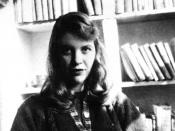Sylvia Plath portrays her life experiences in her first novel, The Bell Jar, through Esther Greenwood, a normal 19 year old woman who tries to live her life New York City. A straight "A" student, Esther is a college correspondant for the town Gazette, editor of her school's literary magazine, and and apprentice to one of the best editors of a popular fashion magazine. Esther wishes to be a poet, however, the pressures of success and love take a toll on Esther's health. Her dream is postponed due to her psychological breakdown and admittance to an mental institution. The Bell Jar deals with a phase in Esther's life when she is influenced by her personal ambition and her involvement with other people, and as a result rebels against the restrictions society has placed on her.
Esther faces many challenges in her life, including the hassles with her profession. Interested in writing and poetry, Esther still does not know exactly what she wants to do with her life.
Esther's uncertaintay scares her. She recalls, "I saw myself sitting in the croth of this fig tree, starving to death, just because I couldn't make up my mind which of the figs I would choose. I wanted each and every one of them, but choosing one meant losing all the rest, and, as I sat there, unable to decide, the figs began to wrinkle and go black, and, one by one, they plopped to the ground at my feet"ÃÂ (63). She is also afraid that if she settles into just one profession she will never be able to get out of it. This phase in her life influences the way she deals with challenging experiences.
Esther's life is influenced by both her personal ambition and by her friend, Buddy Willard. Her personal ambition is unclear. The stresses of deciding on a career lead her to depression. Esther can not write, sleep, or eat. She does not care about the little, important, everyday life activities anymore. She thinks, "It seemed silly to wash one day when I would only have to wash again the next"ÃÂ (104). Another influence on her life is her relationship with long time friend, Buddy Willard. Buddy is in love with her, but she does not feel the same. At first, Esther liked him, but once she realized how hypocritical he was, her thoughts soon changed. These pressures influencing Esther's life lead her to take action, and to try and change her life.
Struggling to change, Esther rebels against the predetermined roles that society feels she should fill as a woman. Esther often has thoughts about suicide and has acted on them on more than one occasion. On one of these occasions, though, she comes far too close to succeeding. An overdose on sleeoing pills nearly kills her. She stole the sleeping pills from her mother and hides in a dark tunnel in her basement. Once she is discovered, unconcious, she is rushed to the hospital and revived. After this episode Esther no longer looked like herself. She does not recognize herself and says, "You couldn't tell whethere the person in the picture was a man or a woman, because their hair was shaved off and sprouted in cristly chicken-feather tufts all over their head. One side of the persin's face was purple, and bulged out in a shapeless way, shading to green along the egdes, and then to a sallow yellow. The person's mouth was pale brown, with a rose-colored sore at either corner. The most startling thing about the face was its supernatural conglameration of bright colors"ÃÂ (142-3). In the end Esther's suicide attmepts lead her to admittance to a psychiatric hospital where she did, though, gradually improve and work her way back to normal mental health.
Sylvia Plath's, The Bell Jar, is a classic because, although it takes place more than thirty years ago, it still deals with issues of people today. It brings back issues dealt with during the early feminist movement, when the book was written. Also, the theme still applies today because, like Esther, many women feel vulnerable and struggle to be taken seriously as a woman in a mans world. The Bell Jar is a fine classic novel that recreates many of the feelings that were, are, and will most likely be, shared by women in society.





